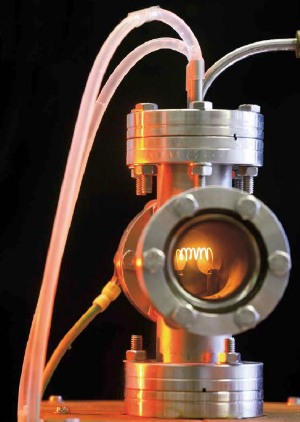Jul 1 2008
Researchers at Delft University of Technology (TU Delft) have developed a technique for generating atom clusters made from silver and other metals. Surprisingly enough, these so-called super atoms (clusters of 13 silver atoms, for example) behave in the same way as individual atoms and have opened up a whole new branch of chemistry. A full account can be read in the new edition of TU Delft magazine Delft Outlook.

If a silver thread is heated to around 900 degrees Celsius, it will generate vapour made up of silver atoms. The floating atoms stick to each other in groups. Small lumps of silver comprising for example 9, 13 and 55 atoms appear to be energetically stable and are therefore present in the silver mist more frequently that one might assume. Prof. Andreas Schmidt-Ott and Dr. Christian Peineke of TU Delft managed to collect these super atoms and make them suitable for more detailed chemical experiments.
Science
The underlying mechanism governing this stability in super atoms was described in Science by scientists from Virginia Commonwealth University in 2005. They had discovered metal super atoms, but from aluminium. Their aluminium clusters of 13, 23 and 37 atoms reacted in the same way as individual atoms because they comprised electrons that revolved around the atom cluster as a whole. These so-called outer layers were strikingly similar to the outer layers of elements from the periodic table.
The super atoms gave the periodic table a third dimension as it were, according to Schmidt-Ott: ‘The chemical properties of the super atoms that have been identified up until now are very similar to those of elements in the periodic table, because their outer layers are much the same. However, we may yet discover super atoms with a different outer layer, giving us another set of completely new properties.'
Schmidt-Ott hopes to find atom clusters with new unique magnetic, optical or electrical properties, which would also be stable enough to create crystals or other solid forms. Potential applications include catalysts in fuel and extra-conductive crystals.
Pure
So although super atoms are nothing new, thanks to TU Delft the particles can now be collected in a very pure form and selected according to size, thereby making them suitable for chemical experiments.
Delft Outlook
A detailed article about these super atoms has appeared in the latest edition of TU Delft magazine Delft Outlook. This edition of the scientific magazine also features the fire in the Faculty of Architecture and an interview with Prof. Marcel Stive, member of the new Delta committee, which will be publishing recommendations about protecting the Netherlands from floods later this year.